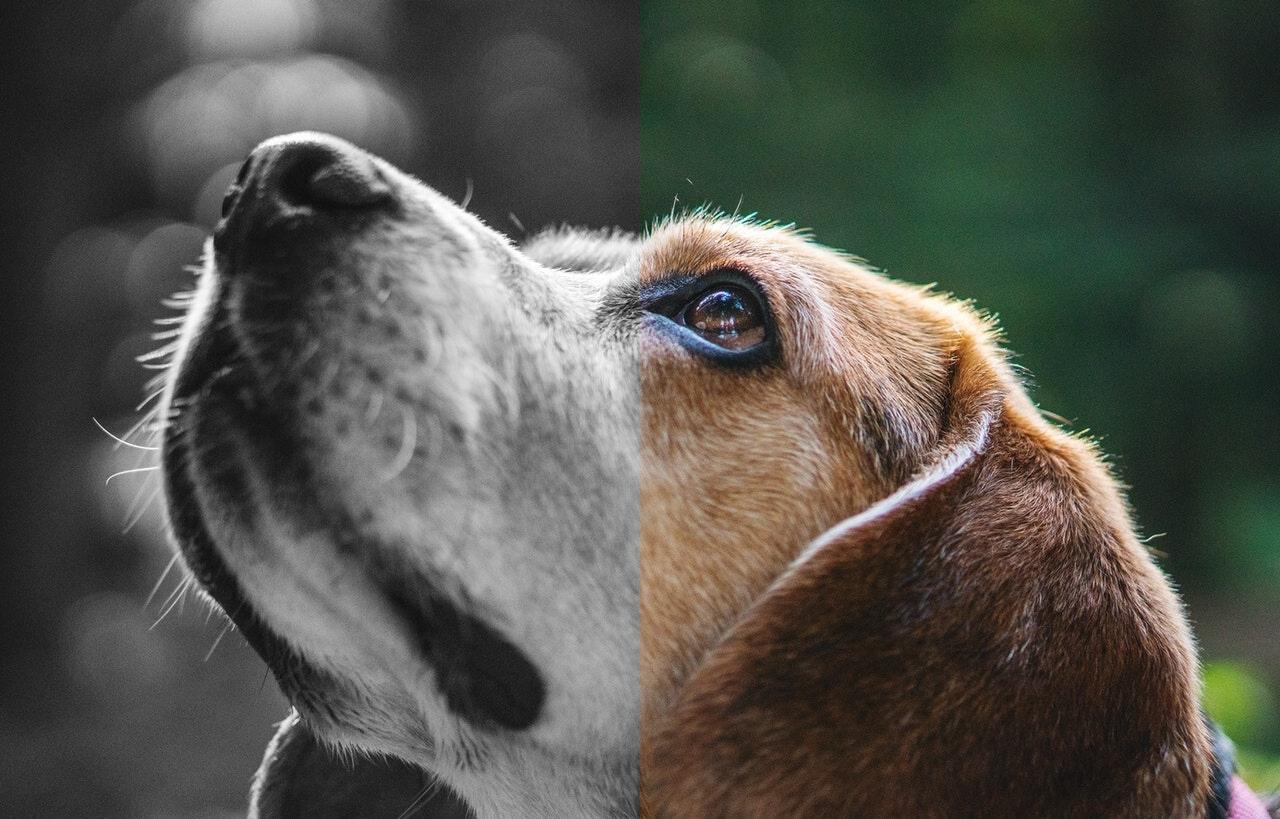
The widespread belief that dogs can only see in black and white has been proven to be incorrect, so what colors can dog’s see? That yellow tennis ball may be more appealing to your dog because it’s easier for him to see than the red one. Dogs do, in fact, detect colors, but not as many or with the same clarity as humans.
This has been established scientifically. However, they still have some advantages that we don’t have. In contrast to humans (and other animals), dogs’ eyes and photoreceptors are built differently, giving them a distinct perspective on the world.
Starting with a dark brown, a dog’s visible spectrum progressively transitions into lighter and lighter brown, yellow, gray, and light blue, until ending with dark blue.
Cones And Rods Make The Difference
What a species sees is determined by the structure of their eyes. Colors are perceived differently by humans and dogs due to differences in cones and rods in the retina, which are located in the back of the eyes.
To begin, you need to look at your retina. It uses the optic nerve to transmit electrical signals to the brain. After arriving in our brains, those impulses are transformed into the visuals we view, including our ability to see color correctly. Colors are the reflected light wavelengths that make up an object’s color.
Blue and yellow are the only colors that dogs can perceive because they have only two cones. It’s called dichromatic vision by the experts. It has the appearance of colorblindness, but it isn’t.
What Colors Do Dogs See?
There are just two kinds of cones in a dog’s eye. As a result, a dog’s color range is limited to tones of grey, brown, yellow, and blue. People who are colorblind in the red-green spectrum have dichromatic vision, which is a similar condition.
Dogs may see some colors as a different shade of brown, such as red and orange. Greens might appear blue. Light blue and dark blue are two shades of the same color, and dogs may not be able to tell the difference between them. Keep this in mind if your dog struggles to find toys or treats. It’s not that he’s not interested—he likely can’t see what you’re trying to give him.
When you’re out shopping for dog toys, go for something bright in color such as blue or yellow that will stick out more to your dog.
What Colors Do Dogs Distinguish Best?
Objects might be more easily found by Dogs if they were a two-tone blue and yellow. Overall, blue and yellow are the most effective hues to employ when training canines to distinguish between different colors. On the other side, perhaps a simple blue or violet object, or even a larger object, would be sufficient.
Are Dogs Color Blind?
If you can’t tell one color from another or can’t see some colors at all, you’re said to be color blind. The eye’s color-sensing receptors are defective, resulting in this disease. Dichromatic vision indicates that dogs, like red-green color-blind people, have yellow-blue dichromatic vision.
They can perceive subtle differences in blues and yellows, but they have trouble discriminating between red and green. While most humans can see three colors at a time thanks to their three-cone color receptors (cones), dogs can see just see 3 or 4 due to their two cone color receptors (cones) (color blind people only have two cones too).
To put it another way, dogs are technically color-blind, but not in the traditional sense.
Can Dogs See In The Dark?
Dogs are excellent night-time observers. This is due to their eyes’ unique anatomy. Dogs’ eyes feature a reflecting membrane at the back, just like those of other predators. The membrane reflects light onto the retina, increasing the amount of light that may enter the eye and enhancing vision in the dark.
Dogs’ eyes appear to shine in the dark as a result of this. Because their retinas contain more rods than those of humans, their eyes are more responsive to changes in light and motion. Detecting strangers or potential prey is much easier for your dog due to this ability.
Other Visual Differences Between Dogs And Us
Canines have an edge over humans when it comes to vision. Peripheral vision is an advantage for dogs since their eyes are located on the sides of their heads, rather than in the middle of their heads. Dogs, on the other hand, have a limited range of visual acuity, which means they lack depth sense.
Pupils in dogs dilate to the maximum extent possible, making it easier for them to see in low-light situations. Canines benefit from improved low-light vision thanks to the tapetum. There are more rod cells in the retinas of dogs compared to human beings, as well. Dogs, compared to humans, have greater night vision and a stronger sense of movement.
Choosing Dog Products Your Pup Can See
Bright red and safety orange are the most popular colors for dog toys and items. For us, these colors make it easy to discover their ball or leash even in the most remote of fields. Dogs, on the other hand, have a hard time distinguishing these colors since they appear either black or dark brownish gray.
The next time your dog runs past their toy, realize that they probably aren’t acting stubbornly. They may not be able to notice anything in the grass. Next time you’re at the pet store, look for toys in bright colors like blues and yellows that your pet will enjoy. This will add to the amusement for both you and your pet.
Conclusion
The dogs experience the world in a distinct color spectrum, based on research. Dogs’ color vision is dominated by yellow and blue. Variations of blue can be seen in blue, blue-green, and violet. To a dog, red and green hues are more likely to appear as brown and grey.






